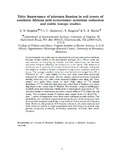| dc.contributor.author | Aranibar, J.N. | |
| dc.contributor.author | Anderson, I.C. | |
| dc.contributor.author | Ringrose, S. | |
| dc.contributor.author | Macko, S.A. | |
| dc.date.accessioned | 2012-03-14T12:13:14Z | |
| dc.date.available | 2012-03-14T12:13:14Z | |
| dc.date.issued | 2003 | |
| dc.identifier.citation | Aranibar, J.N. et al (2003) Importance of nitrogen fixation in soil crusts of southern African arid ecosystems: acetylene reduction and stable isotope studies, Journal of Arid Environment, vol.54, no. 2, pp. 345-358 | en_US |
| dc.identifier.uri | http://hdl.handle.net/10311/983 | |
| dc.description.abstract | Cyanobacterial soil crusts may be important in arid and semi-arid ecosystems because of their ability to fix atmospheric nitrogen (N2). These crusts are very sensitive to trampling by animals, and their destruction can decrease ecosystem N inputs, affecting the productivity of the region. The objective of this study was to quantify the nitrogen-fixing activity in soil crusts during the wet season in southern African ecosystems using in situ acetylene reduction assays. The average acetylene reduction rates for each site ranged from 88 to 535 nmol m-2 h-1, were highly variable, and were lower than previously reported for other arid areas. All soil samples showed acetylene reduction activity; however, soils with crusts supported higher rates than did "non-crusty" soils under litter, moss, or sand. High values of 15N natural abundance (delta15N) indicated that processes other than N fixation were more important in the crusts than N fixation. For example, coupled and ammonia volatilization or atmospheric deposition of 15N-enriched nitrate or ammonium may have caused shifts in delta15N within the soil crusts. The estimated annual N fixation rates ranged from 8 to 44 g N ha-1 year-1, orders of magnitude lower than values estimated in other studies. The anomalous wet conditions experienced during the year of the study may have increased the temporal availability of soil mineral N and decreased N fixation rates. However, the presence of N fixation activity in all crusts analysed and their ability to survive at high temperature and after long dry periods may provide ecosystem resilience, facilitating ecosystem recovery after severe droughts. | en_US |
| dc.language.iso | en | en_US |
| dc.publisher | Elsvier, www.elsevier.com | en_US |
| dc.subject | Soil crusts | en_US |
| dc.subject | N fixation | en_US |
| dc.subject | Kalahari | en_US |
| dc.subject | acetylene reduction | en_US |
| dc.subject | Isotopes | en_US |
| dc.subject | Savanna | en_US |
| dc.title | Importance of nitrogen fixation in soil crusts of southern African arid ecosystems: acetylene reduction and stable isotope studies | en_US |
| dc.type | Published Article | en_US |
| dc.link | http://www.sciencedirect.com/science/article/pii/S0140196302910943 | en_US |

